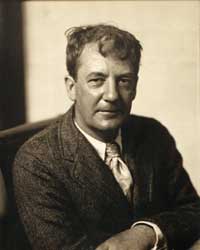Sherwood Anderson: All for Art

The portrait of Sherwood Anderson on view in NPG’s Edward Steichen exhibition was taken for Vanity Fair by Steichen in 1925; Anderson biographer Kim Townsend records that as a great moment for Anderson, he was recognized by the magazine as “America’s most distinctive novelist.”
Born in Camden, Ohio, on September 13, 1876, Anderson was the third of seven children. His father, Irwin McLain Anderson, was a Civil War veteran and a poor businessman, whose efforts to provide for his family led them to Clyde, Ohio. Anderson would always associate the town with his father’s inability to secure a steady means; later, in his writing, Anderson would replace Clyde with the fictional town of Winesburg.
Despite faulting his father for the family’s struggles, Anderson would carry a few faults of his own into four marriages. His first marriage, to Cornelia Platt Lane in 1904, provided Anderson some small happinesses—and three children—but he suppressed his desire to write while working as a copy writer and an executive in a series of businesses. Shortly after the birth of his daughter, Marion, Anderson experienced a breakdown of sorts. The following account is from Irving Howe’s biography, published in 1951:
On November 27, 1912, Anderson told his secretary, “My feet are cold and wet. I have been walking too long on the bed of a river.” A few minutes later he left the factory. He walked out of the town, and for four days he aimlessly wandered about until, on December 1, he was found in Cleveland by a pharmacist.
Although his marriage to Cornelia would survive almost another four years, it would do so only by the most sparse definition of survival. Anderson immersed himself in his writing, and he found much success. Also, his influence on the next generation of writers was great; Anderson boosted the careers of both Ernest Hemingway and William Faulkner. Kim Townsend writes:
From Hemingway’s perspective, Anderson was a man who could help him get there. Anderson did not help him much with his writing. In a few years Anderson would tell his other great protégé—William Faulkner— that he would gladly help him find a publisher for his book as long as he didn’t have to read it. Though he read more of what Hemingway wrote, Anderson helped him, as he would help Faulkner, mostly by his example. He represented professional success, he could say how you achieved it, he could say what you did to maintain it.
Anderson’s stories were well received into the 1920s, and to this day, his novel Winesburg, Ohio is a staple of the American literature classroom. Sherwood Anderson died in March of 1941 in Panama, just as he was beginning research for a work on South America. He is buried in Marion, Virginia, near his home, Ripshin.
References:
Irving Howe, Sherwood Anderson (Stanford: Stanford University Press, 1951).
Kim Townsend, Sherwood Anderson (Boston: Houghton Mifflin, 1987).